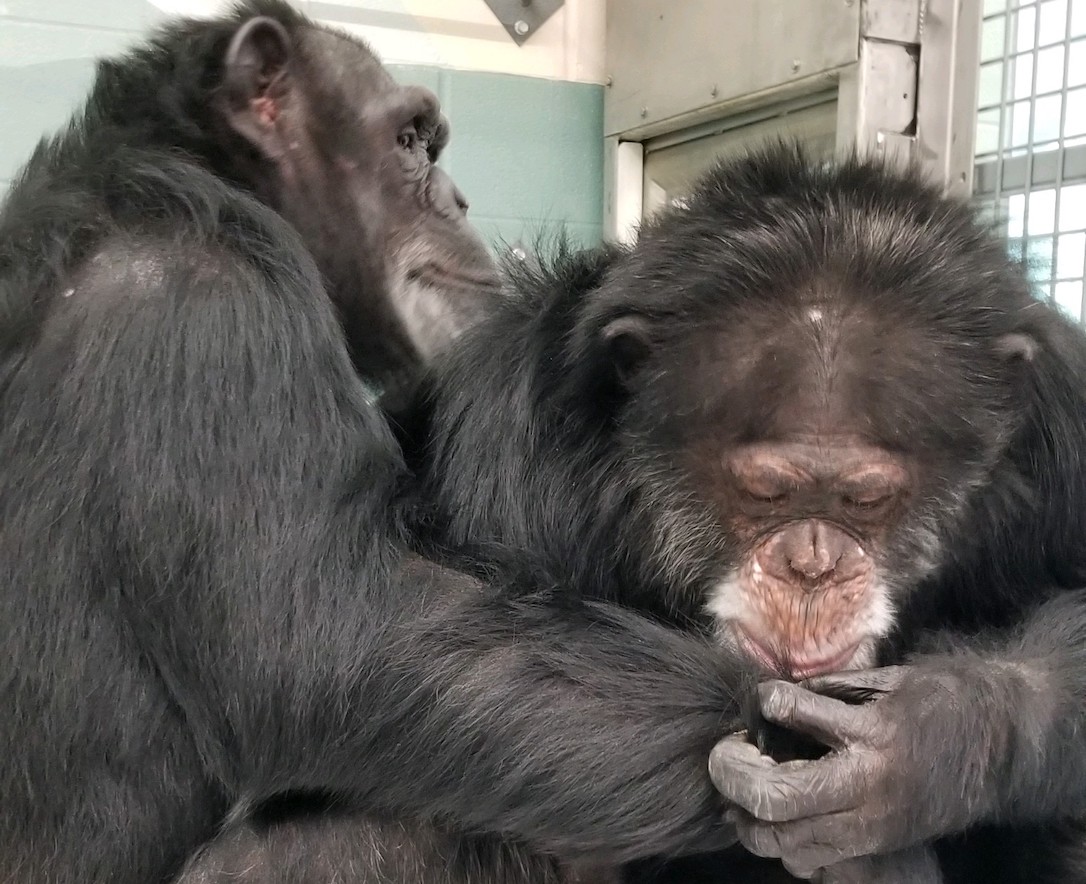We’re happy to announce that our team has begun the process of integrating the six newest arrivals with the three individuals in who arrived in 2019.
This development means that, if all goes according to plan, we’ll be forging a new social group consisting of nine chimps: Cy, Dora, Gordo, Honey B, Lucky, Mave, Rayne, Terry and Willy B.
This will not be easy. As others have explained here in the past, chimpanzees are not biologically predisposed to accept strangers into their group. Although free-living chimpanzees have fluid social dynamics with other members of their community, they can be brutally xenophobic towards outsiders. Males stay with cohorts of related males who frequently wage war on rival communities. Meanwhile, females can only transfer between communities during the brief window of young adulthood when they are sexually mature but have not yet conceived their first infant. Therefore, asking a chimp to become friends with an unfamiliar neighbor is challenging, and asking entire groups to do so is nearly impossible.
With all that being said, merging two groups of chimpanzees is possible in captivity, and it’s often worth the effort; Large, mixed-sex living arrangements give chimps more social partners to choose from, thereby giving each individual more freedom to regulate their social relationships as they wish.
Although it would never occur in the wild, most captive chimpanzees have undergone some sort of social integration at least once in their lives and are somewhat familiar with the process. Because of this, chimps who were raised in labs, zoos and sanctuaries are often more welcoming of new partners than their free-living relatives tend to be. Even so, they’re still generally skeptical and nervous about interacting with chimps outside of their usual configurations and even the best integration methods can go awry.
Many of you probably remember that, in late 2019, we unsuccessfully attempted to integrate Honey B, Mave and Willy B with the group of seven long-time residents that now live on the other side of the building. At that time, we employed an approach that has been successful at several other facilities: we opened the doors, let some chimps into a big room, and hoped for the best. Merging two groups in this manner allows for them to have lots of space during the initial meeting and keeps each chimp close to their established social partners. When this method works, it works well and it works quickly. However, this also creates situations where multiple chimps can form coalitions against their rivals, occasionally leading to chaos and injury for the chimps involved. Unfortunately, that’s what happened here, so we abandoned those integration efforts until circumstances changed.
This time around, we’re going to utilize a slower approach that will likely involve dozens of short, controlled introductions between pairs of chimps while they are separated from their respective groups. First, the participants must be separated from their current partners and shifted into a quiet, restricted space (e.g., the new front rooms). Then, they can have a supervised “howdy” at the caging. If this goes well, caregivers can open the doors and let them interact for a short amount of time before they return to their existing groups.
In these situations, individuals are more likely to behave in a friendly manner because options for forming coalitions and inciting conflicts are both limited. Over time, the chimps will become familiar with each other’s tendencies through these regulated meetings, thus facilitating a smoother transition to a mixed, cohabitating social group when the time is right. Doing these quick introductions is a repetitive and tedious process, but we believe that such a gradual transition will be better for these individuals given their unique personalities and backgrounds.
To coordinate the integration of the two groups, we’ve brought in our friend and colleague Jen Feuerstein as a consultant. Jen is a biologist with twenty years of experience caring for and socializing captive primates, so she’s exactly the person we want to guide us through ambitious endeavors like this one. This week, Jen traveled to Washington from her Florida home to help us with the first round of introductions (which began this afternoon).
Both introductions that occurred today went smoothly!
For the initial icebreaker, we isolated Mave and Lucky in the new wing of the building and then let them meet in new front rooms. These two “hit it off” relatively quickly and spent a good chunk of time hugging, grooming, and playing with each other. Mave was clearly the best chimpanzee to pilot the introduction strategy as she exhibited patience and tenderness at each moment. Lucky was also her usual sweet and goofy self.
When Mave and Lucky appeared done with the initial meeting, we rotated Lucky out and allowed Terry to come in. Terry is a testosterone-driven bruiser of a male chimp, and we weren’t shocked when he immediately barreled around the room and drummed on the caging. Even so, Terry simmered down and showed his gentler side by inviting Mave to meet him at the barrier. She approached and they inquisitively touched each other through the mesh before Mave grew anxious and retreated.
At this point, Jen gave us the signal to open the hydraulic door between the chimps and let them interact freely. Terry charged in and displayed again before settling. Mave kept squealing and jumping back but the two gradually calmed down enough to investigate each other. after a few minutes, Terry began to playfully stomp and skip around, beckoning for Mave to chase him. She hesitantly joined in, and it was only moments before they were laying on the floor grooming each other. This session went on for another thirty minutes or so before we broke it up; Terry didn’t want to leave her side but Mave seemed ready to meet the next chimp in the queue.
These two meetings went well, but we have an arduous road ahead. We expect to do more introduction sessions over the next few days and not all of them will be this easy. Even by conservative estimates, we’ll continue introducing pairs and trios for several weeks before we begin assembling these individuals into larger subgroups. Given the sheer amount work that we have to do, it’s unlikely that we’ll be posting comprehensive updates on a daily basis. Of course, we’ll continue to share the highlights when time allows, but it may be some time before we can share a definitive progress report.
Thank you all for caring about the chimps and for being as invested in their emotional well-being as we are! Feel free to leave comments and ask questions below. 🙂





